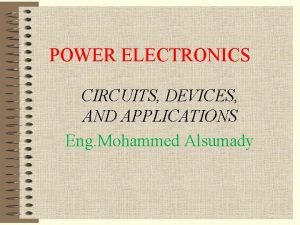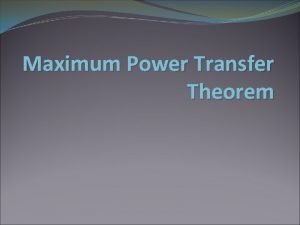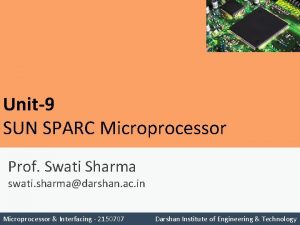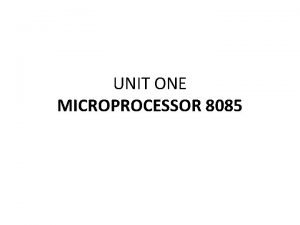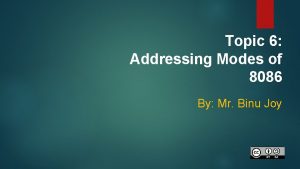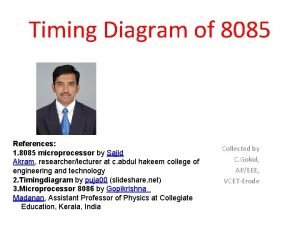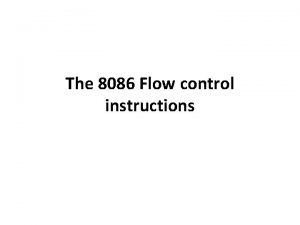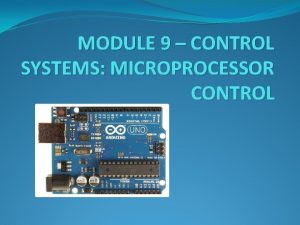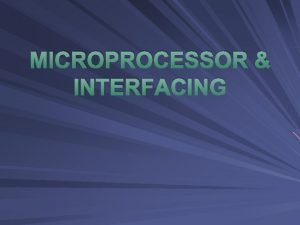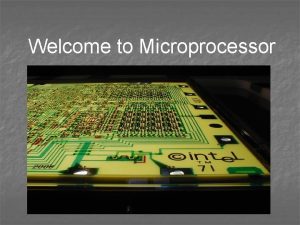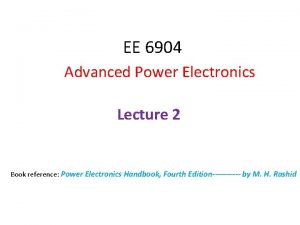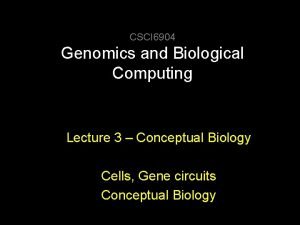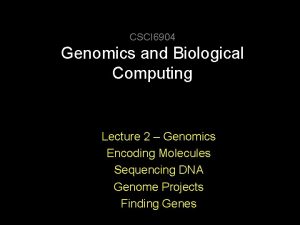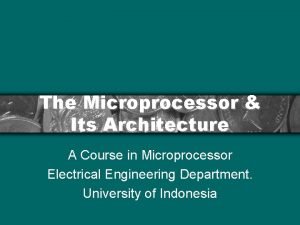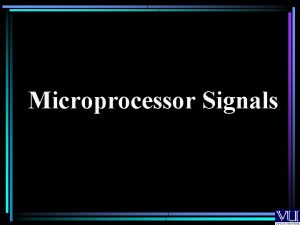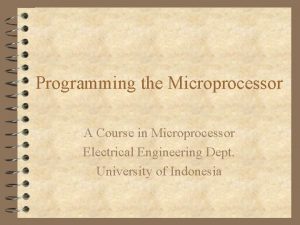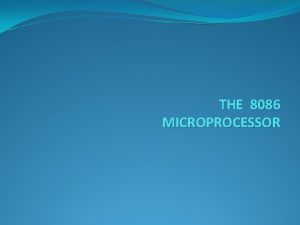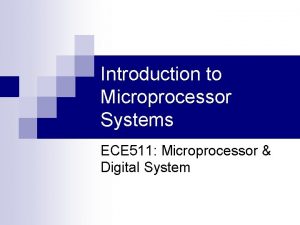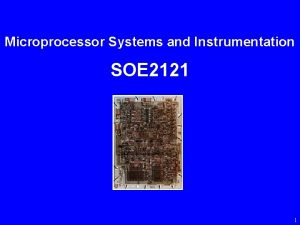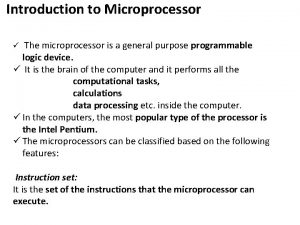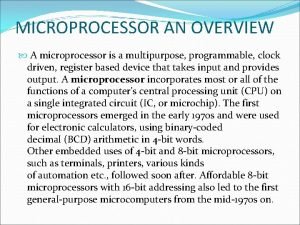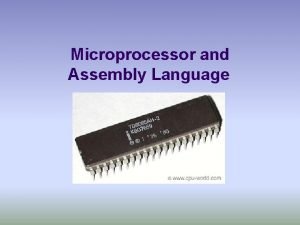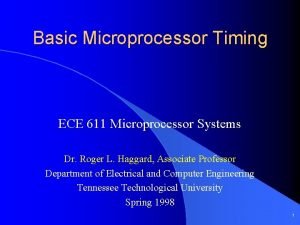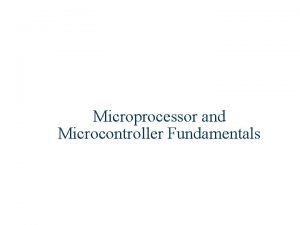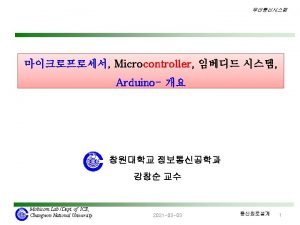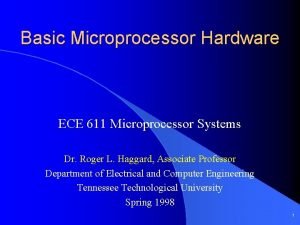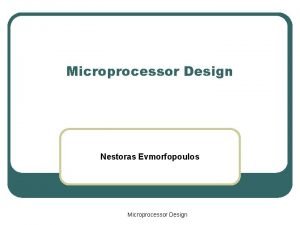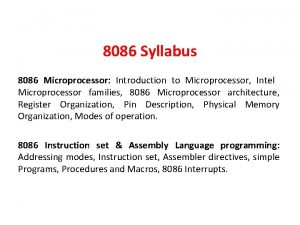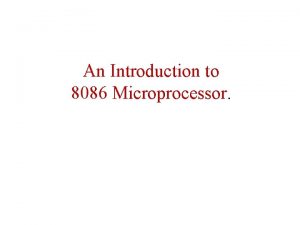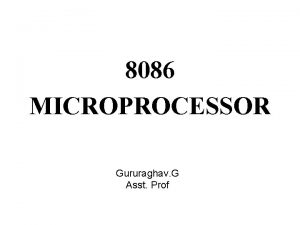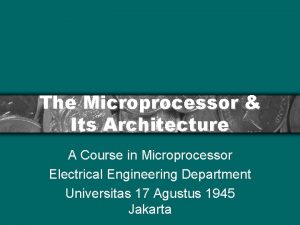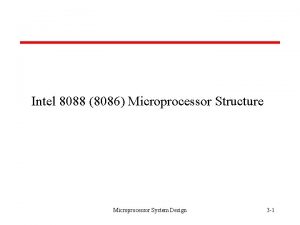EE 6904 Lecture 3 Microprocessor applications in Power


























- Slides: 26

EE 6904 Lecture 3 Microprocessor applications in Power Electronics & Non-isolated and Isolated DC/DC Converters Book reference: Power Electronics Handbook, Fourth Edition------ by M. H. Rashid Part of the lecture is taken from the link: https: //www. ee. iitb. ac. in/student/~cmouli/index_files/ee 675_slides_20%20 OCT%2008. pdf

Learning Outcome At the end of this course, students will be able to LO 1: familiar with the advanced semiconductor devices applied in power electronics and also their using technique in power electronics LO 2: design isolated and non-isolated dc-dc converters 2/25/2021 Department of EEE, KUET 2

Typical Control Structure of a Power Electronic System 2/25/2021 Department of EEE, KUET 3

Microcontrollers 2/25/2021 Department of EEE, KUET 4

Microprocessors 2/25/2021 Department of EEE, KUET 5

Digital Signal Processors 2/25/2021 Department of EEE, KUET 6

2/25/2021 Department of EEE, KUET 7

2/25/2021 Department of EEE, KUET 8

Non-isolated and Isolated DC/DC Converters: transformer less and transformer based converters 2/25/2021 Department of EEE, KUET 9

Design consideration • High quality • Small in size • Light-weight • Reliable • Energy efficient 2/25/2021 Department of EEE, KUET 10

Functions of dc/dc converters 2/25/2021 Department of EEE, KUET 11

Types of dc/dc converters • Pulse-width-modulated (PWM) converters • Resonant and soft-switching converters Advantages of PWM converters: • Low component count • High efficiency • Constant frequency operation • Relatively simple control and commercial availability of IC controllers • ability to achieve high conversion ratio 2/25/2021 Department of EEE, KUET 12

Applications of dc-dc converters • High performance dc drives: electric traction, electric vehicles and machine tools • Power supply: x-ray lamp (tens of kilowatts), 3. 3 V for modern microprocessor, 5 V and 12 V logic circuits, 48 V for telecommunication equipment, and 270 V for main dc bus on airplanes. • Distributed power supply system • Utility ac grid--- for UPS, battery chargers etc. • Power factor correction (PFC) 2/25/2021 Department of EEE, KUET 13

DC Choppers Fig. 1 DC chopper with resistive load, (A) circuit diagram and (B) output voltage waveform 2/25/2021 Department of EEE, KUET 14

DC Choppers Fig. DC chopper with RLE load, (A) circuit diagram and (B) output voltage waveform 2/25/2021 Department of EEE, KUET 15

DC Choppers Fig. The dc step-up chopper 2/25/2021 Department of EEE, KUET 16

Step-down (buck converter) Fig. Buck converter, (A) circuit diagram and (B) waveforms 2/25/2021 Department of EEE, KUET 17

Forward Converter • In the forward converter, the energy-transfer current flows through the transformer in one direction • This converter is popular for low power application • for medium power levels, converters with bidirectional transformer excitation are preferred due to better utilization of magnetic components 2/25/2021 Department of EEE, KUET 18

Push-Pull Converter Transformer is excited with bidirectional current, hence core saturation is not a problem. 2/25/2021 Department of EEE, KUET 19

Half-Bridge Converter D<=0. 5 In comparison with the push-pull converter, the primary of the transformer is simplified at the expense of two voltage-sharing input capacitors 2/25/2021 Department of EEE, KUET 20

Full-Bridge Converter D<=0. 5 • This is a versatile converter • It is very popular in dc-ac conversion and four-quadrant dc drives 2/25/2021 Department of EEE, KUET 21

Step-Up (Boost) Converter Fig. Boost converter, (A) circuit diagram and (B) waveforms 2/25/2021 Department of EEE, KUET 22

Buck-Boost Converter Fig. Buck-boost converter, (A) circuit diagram and (B) waveforms 2/25/2021 Department of EEE, KUET 23

Flyback Converter Fig. Buck-boost converter, (A) circuit diagram and (B) circuit with a transformer model showing the magnetizing inductance 2/25/2021 Department of EEE, KUET 24

Ćuk Converter (A) Fig. Ćuk converter, (A) circuit diagram and (B) waveforms 2/25/2021 Department of EEE, KUET (B) 25

Lecture 4 SEPIC, Zeta, power factor correction at ac mains in these converters, their application in SMPS, UPS, welding and lighting. 2/25/2021 Department of EEE, KUET 26
 01:640:244 lecture notes - lecture 15: plat, idah, farad
01:640:244 lecture notes - lecture 15: plat, idah, farad Power triangle formula
Power triangle formula Power system dynamics and stability lecture notes
Power system dynamics and stability lecture notes Power system analysis lecture notes
Power system analysis lecture notes Power semiconductor devices lecture notes
Power semiconductor devices lecture notes Switch mode power supply lecture notes
Switch mode power supply lecture notes Power system dynamics and stability lecture notes
Power system dynamics and stability lecture notes Power electronics circuits devices and applications
Power electronics circuits devices and applications Application of maximum power transfer theorem
Application of maximum power transfer theorem Solar power satellites and microwave power transmission
Solar power satellites and microwave power transmission Potential power
Potential power Flex power power supply
Flex power power supply Spectrometer dispersive power of grating
Spectrometer dispersive power of grating Power of a power property
Power of a power property General power rule vs power rule
General power rule vs power rule Power angle curve in power system stability
Power angle curve in power system stability Power bi training powerpoint
Power bi training powerpoint Power delivered vs power absorbed
Power delivered vs power absorbed Microprocessor
Microprocessor Microprocessor system with bus organization
Microprocessor system with bus organization Intel 8085 microprocessor
Intel 8085 microprocessor Addressing modes of 8086 microprocessor
Addressing modes of 8086 microprocessor Demultiplexing of buses in 8085 microprocessor
Demultiplexing of buses in 8085 microprocessor 8085 microprocessor timing diagram
8085 microprocessor timing diagram Cmp in 8086
Cmp in 8086 Microprocessor control system
Microprocessor control system Limitations of 8085 microprocessor
Limitations of 8085 microprocessor







